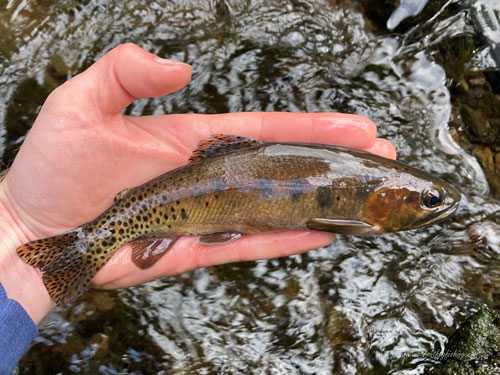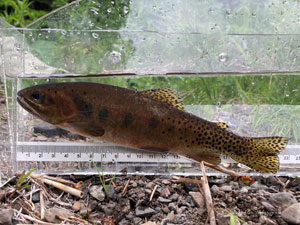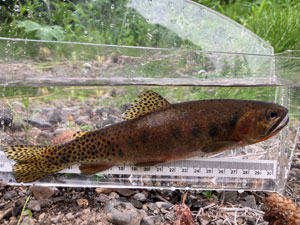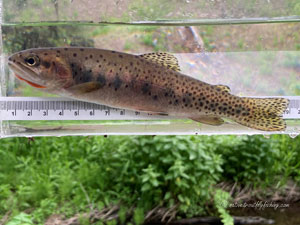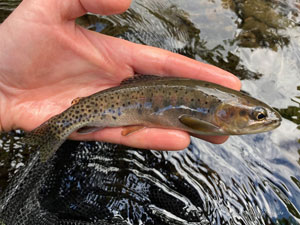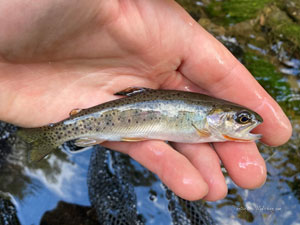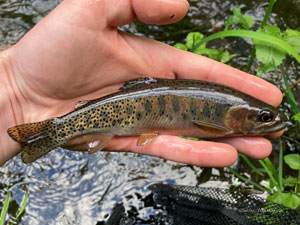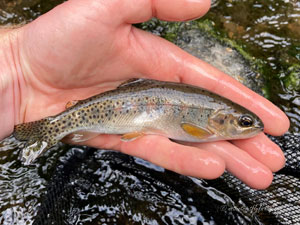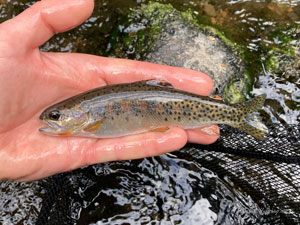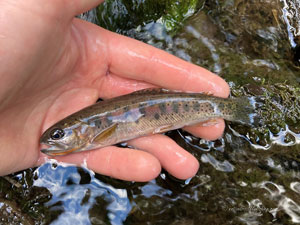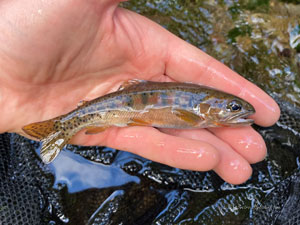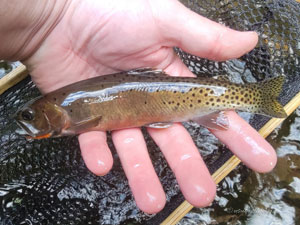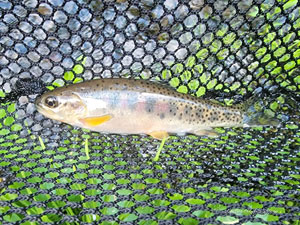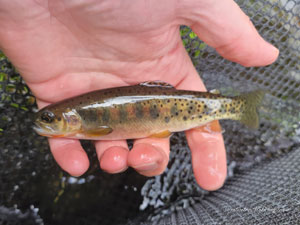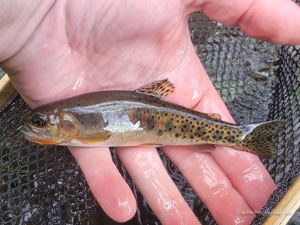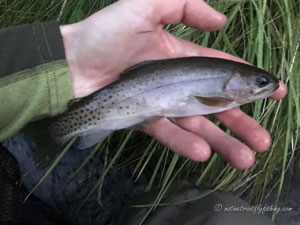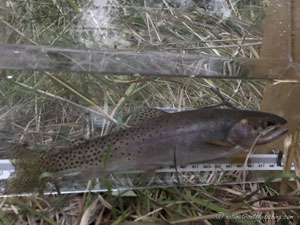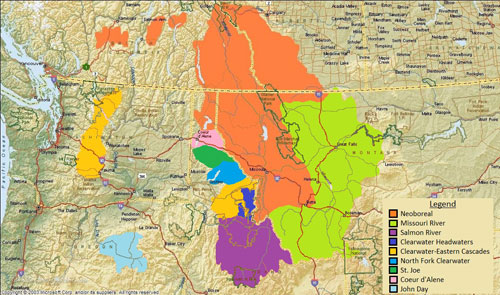John Day Westslope Cutthroat
Oncorhynchus lewisi ssp.
A stream resident John Day Westslope Cutthroat from an Oregon stream.
Introduction
The John Day Westslope Cutthroat Trout has the smallest of native range of the Westslope Cutthroat subspecies and is native to about 220 miles (355 km) of 41 tributaries to the John Day River watershed in Oregon. These fish occur further downstream in the Columbia basin than any other Westslope Cutthroat and form an isolated disjunct population far removed from the core range of Westslope Cutthroat Trout. Due to this historically there was debate as to whether these Cutthroat were native or not (Behnke 1992, Behnke 2002). However, genetics indicate that they are the most divergent lineage of Westslope Cutthroat and likely represent an ancestral population that should be considered as a distinct subspecies (Howell et al. 2003, Trotter et al. 2018, Young et al. 2018). In addition to the known native populations, Westslope Cutthroat are also found in several streams in the North Fork John Day River, where they were known to be stocked, however it is still unclear whether these North Fork populations are results of stocking or are also native (Trotter 2008, Young et al. 2018).
Life History Information
The life history of the John Day Westslope Cutthroat is currently poorly understood, but these fish are thought primarily exhibit a stream resident life history, although fluvial (river migrant) life histories are also found in the watershed. John Day Westslope Cutthroat are primarily drift feeders, preying on aquatic and terrestrial invertebrates and generally reach a maximum size of around 12” (31 cm). The preferred habitat for these fish are plunge pools or pools with large wood debris in them, which provide both holding water and cover from predators. These Cutthroat typically have small home ranges, which are typically between 115 ft to 367 ft (35 m to 112 m), however during spring John Day Westslope Cutthroat have observed to migrate up to 2.3 miles (3.8 km) upstream to spawn (Starcevich 2005). After spawning these fish will migrate back downstream, with most of the fish homing back to their home territory.
Status
The John Day Westslope Cutthroat Trout is not listed under the Endangered Species Act but is considered to be at risk of extinction by the Oregon Department of Fish and Wildlife (ODFW 2005) and are estimated to only inhabit 21% of their historic range (Shepard et al. 2003). The John Day basin has a long history of environmental degradation, including livestock grazing, agriculture, mining, logging and the trapping of beavers, which have all had negative effects on the Cutthroat populations. In many of the streams in the basin beavers remain uncommon and as the John Day Westslope Cutthroat’s preferred low velocity pool habitat is currently limited this likely has a negative impact on the total abundance of these fish compared to historic conditions. In addition, due to elevated stream temperatures and low flows from water withdrawals for irrigation and the loss of riparian habitat, most populations in the basin are functionally isolated from each other. The exception to this are tributaries to the upper mainstem John Day River, where Cutthroat have access of over 57 miles (92 km) of connected habitat (ODFW 2005). Today about 70% of the John Day Westslope Cutthroat’s current distribution is located on public lands providing some level of protecting from future environmental degradation.
Most populations of the John Day Westslope Cutthroat are found in the extreme headwaters of the basin above areas that are typically occupied by native Columbia Basin Redband Trout. Where these two species of trout meet, there appears to be some level of natural hybridization, however where hatchery Rainbow Trout have been stocked hybridization can become much more extreme and due to this several populations in the basin are dominated by hybrid a swarm of hatchery Rainbow Trout x Cutthroat crosses (Howell et al. 2003). In addition to hatchery Rainbow Trout, Brook Trout have also been stocked in the upper John Day and negatively impact Cutthroat due to competition and predation. Fortunately, the Oregon Department of Fish and Wildlife discontinued the stocking of non-native trout into streams in the upper John Day basin in 1997, which will help to ensure that these unique Cutthroat persist into the future.
Description
The John Day Westslope Cutthroat Trout are similar in appearance to other Westslope Cutthroat, although they often have a drabber coloration. The coloration on the backs and sides of these fish is typically an olive, bronze or even grayish color. The side of these fish range from a grayish color to tan or bronze and the bellies and gill plates typically show a peach to bright orange color and this same color may be found along the lateral line, often between the parr marks on smaller individuals. Spots are typically irregularly shaped, small to medium sized and concentrated towards the posterior region of the body and along the back with relatively few spots found below the lateral line in the middle of the body. Their fins typically are a yellow to orange or peachy color and spots are typically found on the dorsal, adipose and caudal fins.
Stream Resident Form
Click on images to view a larger picture
Fluvial Form
Click on images to view a larger picture
Native Range
Above: A map of the native range of the Westslope Cutthroat trout. Data Sources: Behnke (2002), Trotter (2008) and Young et al. (2018). Below: A map of the native range of the John Day Westslope Cutthroat Trout.
References
Behnke, R. J. 1992. Native trout of western North America. American Fisheries Society Monograph 6. American Fisheries Society, Bethesda, Maryland.
Behnke, R. 2002. Trout and Salmon of North America. Chanticleer Press, New York.
Howell, P, P. Spruell and R. Leary. 2003. Information regarding the origin and genetic characteristics of westslope cutthroat trout in Oregon and Central Washington. United States Forest Service. La Grande, Oregon. 18p.
ODFW. 2005. Oregon native fish status report. Oregon Dept. of Fish and Wildlife, Salem, OR.
Shepard, B.B., B.E. May, W. Urie, C. Corsi, K. McDonald, R. Snyder, T. Unterwegner, J. Uehara and K. Walker. 2003. Status of westslope cutthroat trout (Oncorhynchus clarki lewisi) in the United States 2002. WCT Multi-State Assessment.
Starcevich, S.J. 2005. Seasonal movement patterns and habitat use of westslope cutthroat trout in two headwater tributary streams of the John Day River. Master's thesis, Oregon State University, Corvallis, OR.
Trotter, P. 2008. Cutthroat: Native Trout of the West. Second Edition. University of California Press, Berkley, CA.
Trotter, P., P. Bisson, B. Roper, L. Schultz, C. Ferraris, G.R. Smith and R.F. Stearley. 2018. A special workshop on the taxonomy and evolutionary biology of cutthroat trout. Pages 1-31 in Trotter P, Bisson P, Schultz L, Roper B (editors). Cutthroat Trout: Evolutionary Biology and Taxonomy. Special Publication 36, American Fisheries Society, Bethesda, Maryland.
Young, M.K., K.S. McKelvey, T. Jennings, K. Carter, R. Cronn, E.R. Keeley, J.L. Loxterman, K.L. Pilgrim and M.K. Schwartz. 2018. The phylogeography of Westslope Cutthroat Trout. Pages 261-301 in Trotter P, Bisson P, Schultz L, Roper B (editors). Cutthroat Trout: Evolutionary Biology and Taxonomy. Special Publication 36, American Fisheries Society, Bethesda, Maryland.
Contact
Feel free to contact me if you have any questions or comments
John Day Westslope Cutthroat Trout Links
My John Day Westslope Cutthroat Trips
Oregon Department Fish and Wildlife - Westslope Cutthroat Trout
Strawberry Mountain Wilderness Area
Western Native Trout Initiative - Westslope Cutthroat Trout
Native Trout Links
Truchas Mexicanas' - Native Trout of Mexico
Balkan Trout Restoration Group
Trout and Seasons of the Mountain Village - About Japanese Trout
Western Native Trout Challenge
California Heritage Trout Challenge
Fly Fishing Blogs
Dave B's Blog: Fly Fishing for Native Trout
The Search for Native Salmonids
Conservation Links
Western Native Trout Initiative
Fly Fishing Links
Fishing Art Links
Americanfishes.com - Joseph R. Tomelleri
